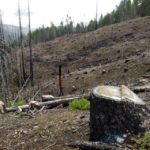Does Salvaging Scorched Trees Hurt the Environment?
Posted: June 22, 2017Source: www.theatlantic.com
Removing trees killed by fires might not be as damaging to forests as previously thought.

Jeff Barnard /AP
When a forest burns, the aftermath is a post-apocalyptic landscape of smoldering black trunks. The forest’s managers, whether they work for the U.S. Forest Service or for private companies, sometimes send in heavy machinery to harvest the dead trees in a process called salvage logging, to turn them into boards or other products. The idea is that since the trees are already toast, the responsible thing is to get a little more value out of them before they start to rot, as well as to remove fuel for a future fire from the area.
But salvage logging can be controversial. It churns up the fire-damaged soil. It may introduce seeds from invasive species, carried by the machinery. And dead trees, known as snags, are habitats for woodpeckers and other wildlife. Does removing them hamper the long-term recovery of the forest? More than 10 years ago, researchers from of the Forest Service’s Pacific Southwest Research Station decided to take advantage of a fire in the national forest near Mount Lassen, in Northern California, to study this question, and recently published their surprising results: At least on plant life, salvage logging did not have as much of an effect as one might expect.
At the beginning of the study, the researchers laid out 15 plots in the area burned by the Cone Fire, an accidental blaze that swept through the park’s dry pines in 2002. They directed salvage logging efforts of varying intensity in some plots and left others untouched. Then, every two years, they returned to the plots to count the number of plants and plant species that had sprouted, keeping track of which were natives, which were invasive, and whether they were weedy plants or shrubs, among other factors. Interestingly, the weedy plants that grew over the years were the same whether the plot had been logged or left to its own devices. The disturbance of the machinery did not appear to affect what grew, and didn’t seem to tip the scales to favor invasive species. Even cheatgrass, an invasive legendary in the West for its aggressive spread and alarming flammability, showed up in similar amounts regardless of the plots’ treatment.
They did find that native shrubs were a bit scarcer in the plots that had been heavily salvaged. That may be because the machinery came in a year after the fire, when buried seeds of these species, whose germination is triggered by fires, were putting up vulnerable saplings, says ecologist Eric Knapp, one of the study’s two authors. But even that difference was not large.
It seems that the effects wrought by the fire itself, which burned very intensely and destroyed all the trees and other vegetation in the plots, had more weight in how the ecosystem responded than the treatment that came after, Knapp says. This suggests that focusing attention on avoiding such a high-intensity fire altogether, perhaps through the use of smaller, controlled fires that keep the amount of fuel from building up, would have more of an impact than whether salvage happened or not. “If we would have been able to, say, do a prescribed burn, or thin and burn before, we could have prevented this wholesale conversion of the forest,” Knapp adds.
The study was an ideal version of salvage logging, with relatively flat land, rocky, harder-to-erode soil, and other characteristics that might have limited the damage, and the researchers caution against assuming that these results would apply everywhere. But over the last few years, other studies have started to show similar effects in very different forest environments, Knapp says. So decisions about whether to salvage log or not perhaps can be made on the basis of factors other than the recovery of the grasses and shrubs. (New trees, he notes, were very, very few. Unless they are planted, it will take a very long time for forest to return.)
Going forward, the timing of salvage logging—doing it as soon after the fire as possible—could help avoid damaging native shrubs that germinate later, the researchers say. And in situations where less shrub cover is what forest managers want—if, for instance, they are planting seeds for new trees and don’t want them to be overwhelmed—then salvage logging a year after the fact might even be helpful, a replacement for herbicide.
In general, Knapp says, apart from the practical implications, the study has given him a real appreciation for the resilience of native species. “Even after being burned at high severity and run over with heavy machinery, the plants still came back!” he says. “Years after the scars of salvage were no longer evident, it was actually quite beautiful out there with flowers of all different colors, pollinators buzzing, and birds singing. … Even if it doesn’t look great right after a fire or after logging, sometimes one might just need to wait a few years.”
